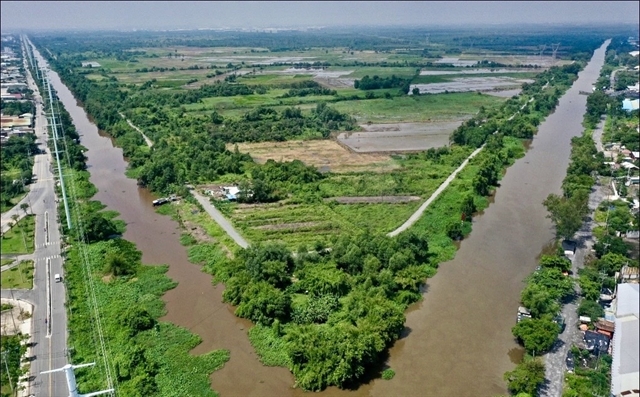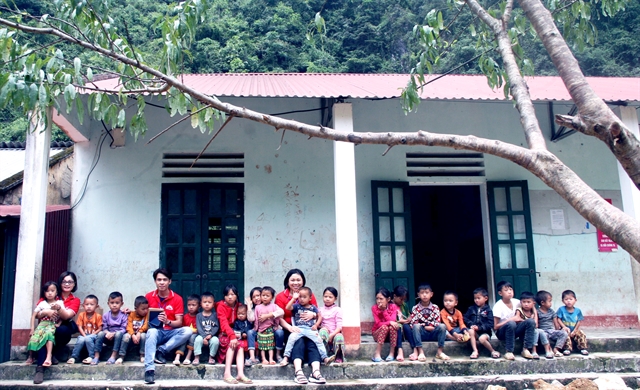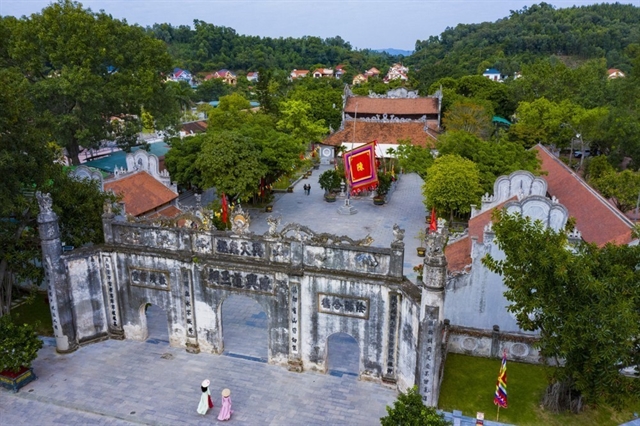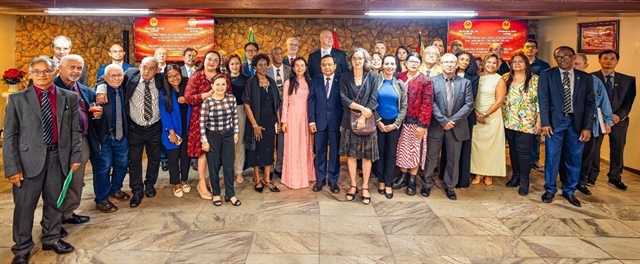 Society
Society

Most of Phố Cáo Commune in the northern mountainous province of Hà Giang, save for a small area of relatively flat valley, is marked by sharp rocks and treacherous slopes with a scattered population living amongst the great wilderness.

|
| Teachers and H'Mông students posed for a photo at Phố Cáo Primary School's satellite facility in Sảng Pả Village in Cáo Phó Commune, Đồng Văn District of the northern mountainous province of Hà Giang. — VNA/VNS Photo Trần Quang Vinh |
HÀ GIANG — Most of Phố Cáo Commune in the northern mountainous province of Hà Giang, save for a small area of relatively flat valley, is marked by sharp rocks and treacherous slopes with a scattered population living amongst the great wilderness.
Nearly all of the people here belong to the Mông ethnic minority, whose sole means of livelihood is traditional agricultural practices that bring very little income given that there is not much arable land this high up.
Socio-economic conditions in Phố Cáo are not unlike other poor, ethnic minority-dominant communities across the northern localities of Việt Nam, but in the last four to five years, education has really been looking up.
As Mông children are inspired to enjoy learning and going to school, teachers no longer have to feel like they are pursuing a lost cause as the days of forgoing their teaching duties to go knocking on doors to urge Mông children to come back to school seems to be behind them.
The head of Phố Cáo primary school, Nguyễn Thị Hạnh, who oversees 58 teachers and staff divided between the main facility and 14 satellite schools 10-13 kilometres away from each other, is not a local but originally from the capital city of Hà Nội.
“I have lived in the uplands for more than 25 years and now I think I can call myself a citizen of the Đồng Văn karst plateau,” she said.
“My house is here, my little family is here. My son is following in my footsteps and now has become my colleague. It’s not easy managing all these scattered schools – some cannot even be reached by motorbike, you have to go up on foot and the hike will take at least one and a half hours,” Hạnh said.
“Đồng Văn is misty and rainy nearly all year round, while the winter is freezing cold,” she added, further compounding the road to schools.
Phố Cáo Commune has 18 villages – including three border villages – but a total of 15 primary and kindergarten schools.
This means that the local students find the journey to school easier, their parents could be spared a burden and focus on making a livelihood in these poor lands, while the inconveniences of long winding and treacherous paths are shifted onto the teachers.
The male teachers usually took up the jobs in the most remote locations while the nearer spots are given to female teachers, those who are with small children or are at an advanced age.
Hạnh said that two of the school’s managers are both females so they take turns each week to visit the satellite schools to get hold of the situation there.
Thanks to the Party and State policies and the commitment from the teachers, currently Phố Cáo Commune no longer has any school-age child that are not going to school.
“H’Mông children have now learned to like studying and are willing to go to school,” Hạnh said, adding that the school currently has 410 female students out of 833, translating to a female ratio of nearly 50 per cent.
Hoàng Thị Thanh Bình, a teacher, said that classrooms at Phố Cáo school’s satellite facilities in Sảng Pả and Xẻo Lủng villages were built in 2010.
“At a glance, the infrastructure looks decent but on closer inspection, one can see that the roof is covered in old tiles and the bricks seem ready to crumble at any time,” Bình said, adding that H’Mông parents and teachers hope that the State soon invests in upgrading the facilities, especially as this area is prone to cyclones.
A new small school Pho Chi is being built 13km away from its parent school near the border and construction is expected to be finished by the end of September.
The school’s construction has been competed thanks to VNĐ320 million (US$14,100) in donations from generous philanthropists who wished to see an education facility for children in the area farthest removed from the commune’s centre.
Pho Chi Village has just 22 households and nine children in second-grade, two in first grade that have been entrusted to another school, and no children in third or fourth grade.
The lack of school supplies like textbooks, notebooks, pens and blackboards is a serious concern among teachers here.
Ironically, in this regard, the poorer households are doing better as they receive support from the Government, while the near-poor households struggle to provide for their own children even though the line between near-poor and poor household here is really not that distinct.
This school year is a luckier year for children, as a charity group (Bridges between the Hearts) based in Hà Nội had visited the school and donated textbooks, notebooks and other practical items for the Mông children here, alleviating burdens on their families.
Bridging the gap
Hạnh said that despite all the difficulties, Phố Cáo students have made their names known at competitions at a province-level over the last two years, which is something that teachers in the poor communes of mountainous localities “couldn’t even imagine in their wildest dreams”.
Aside from efforts to enhance the quality of teaching, the students’ improved academic performance could be attributed to improvements in their Vietnamese language proficiency, which would help them better understand the lectures and communicate with teachers: 80 per cent of the first-grade students in this school year (2019-20) have already been able to speak and listen to Vietnamese quite well since they learnt the language in kindergarten.
All Phố Cáo primary schools are also upholding the requirements that there must be at least 20 Vietnamese language classes taught to the Mông children before the first-grade students start their new school year.
During the school year, if it arises that the students need further lessons, the teachers would hold free classes for them as well.
In return, Mông language mastery is compulsory for all teachers of other ethnicities, not only to help explain the Vietnamese lessons to the children but also a great asset to establish rapport with the Mông students.
In Phố Cáo primary school, in addition to seven Mông teachers, their colleagues will need to obtain a Mông proficiency certificate in place of the usual English certificate.
Nguyễn Thị Hạnh said that “every improvement, no matter how small it might seem, takes tremendous efforts from the teachers, since their efforts are not bolstered by support from the parents.
“The locals might understand the important role of Vietnamese language but most students here have lived with their family their whole life – who might have not gone to school or can’t speak Vietnamese.
“There is no industrial park in Phố Cáo Commune or Đồng Văn District so adults need to travel very far to work, entrusting their children’s’ educations to the schools and the teachers here,” Hạnh said. — VNS




